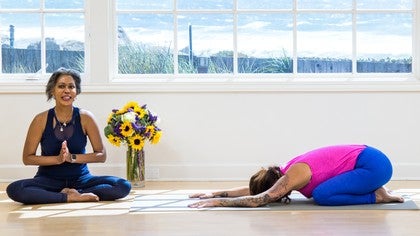Description
About This Video
Transcript
Read Full Transcript
Hello everyone, thank you for being here. We are at the point now where we have already talked a little bit about foundation, we talked a little bit about core and then the last piece of our metaphor is with expression. So just to review that metaphor again, the whole idea is I am the vessel and the whole my job is to keep this vessel clear so that spirit can do the work. Spirit can do the work that it needs to do and our analogy talks about addiction as turning our vessel upside down. So again in my case I was in the water upside down for many many years.
Then the first three steps of the 12 step program are the foundation steps which help turn that vessel, support that vessel in turning back right side up. From there steps 4 through 9 we speak of as the core steps, these are the action steps. The vessel has been in the water upside down for all those years, it's pretty frickin dirty. So these are the steps that help sweep that vessel out and prepare it for sale. So we spoke a little bit about the core steps and again how this analogy works very well when we are doing work with the body, the somatic work as well.
In every posture we first find foundation. Once we find that sense of connection with mother earth, with the foundation, whatever touches the earth is our foundation. So once we find that sense of foundation then we hug our energy in, we reclaim, we receive from mother earth below us to really receive that energy, hugging the energy in, muscle to bone. The last piece of this little metaphor is expression. Now that we've got foundation and core, expression is available.
So our vessels turn back right side up. We've done some work to prepare that vessel for sale. Now with the expression we're able to set sail truly with ease on our spiritual voyage. So in the 12 step program very often these steps are called the maintenance steps. I'm not really a big fan of the word maintenance in that it kind of sounds like there's nothing to do, that you just kind of chill and my experience with this is that that's not the case with these steps.
I like to call them the sustainability steps. So rather than maintenance I often use the word sustainability because I want to sustain that sail, setting sail on my authentic spiritual voyage and it requires some attention to do that. That sustainability piece really requires some attention. So again now that with foundation and core we've got that sense of what Patanjali and the yoga sutra calls sthira. I've got that sense of steadiness.
I've got that sense of foundation. I've even begin to build a little sense of courage, a little sense of confidence. So there's a steadiness here. There's a foundation that's available for me at this point. Now I look to the sukha.
And we know in the yoga sutras, as a matter of fact is yoga sutra 246, Patanjali speaks of the two qualities of asana, postures. He says that they are sthira and sukha. So the first thing we do is find our foundation. We find that sense of steadiness. But in this case, in our recovery case, is given to us via steps one through nine.
And now we set sail. And to do that we need the sukha. So in all this, so we can kind of see how this all works together. We're connecting dots and we can see how these things begin to work together in both the cognitive effect of the 12-step program and then the somatic work, the body-based work that we do within yoga. So steps ten through twelve, step ten says we continue to take personal inventory and when we were wrong promptly admitted it.
So we've done the work in the previous step. We did that deep inventory work that we talked about in the core piece, in that whole thing, looking at ourselves deeply with swadhyaya, looking at ourselves in a very deep, reflective way. So we've done that cognitive work, the deep cleaning, if you will. How do we keep that vessel clean? How do we continue to keep that vessel clean?
Well the 12-step program gives us a way to look at that. It says we continue to take personal inventory and when we were wrong promptly admitted that. So with some daily self-reflection, with some ways to really examine our daily activities and whether or not we're in integrity with ourselves. Now in these steps we deepen that spiritual principle of integrity. Integrity again is where our speech, our actions, our thoughts align with our values, right?
They align with what it says, what we say is most important to us. When my speech, my actions, my thoughts are not aligned with what I say is most important to me, then I'm out of integrity with myself, right? So the daily races is kind of important to me to look at my day and see if I was out of alignment anyway. If I am, then that energy of being out of alignment, anything that lies, according to the yogis, really according to Ayurveda, anything that lies in this system, unresolved, unfinished, incomplete, undigested, causes ama or poisons to build up in this system. And again that might be an undigested piece of food in the belly or it might be an undigested experience of my day.
So the four-step work gives us a way to go back in our history to do some deep cleaning around that, but this step and step 10, we get a chance to look at this on a daily basis. This day are my thoughts, my actions, my speech in alignment with what I say is most important to me. And if it isn't, right, that means, you know, I don't want to leave that poison just laying in the system, I don't want to do that because that's going to cause residual effect. So I don't want to leave that poison in my system. This step gives me a way in order to resolve in this day what otherwise might have been left unresolved.
So I go back and I review my day and I look at, you know, whether anything's out of alignment or integrity and then I would take the actions of what's needed to resolve that. Now for me, you know, having done the deep work, a lot of times it might be something or someone, let me give you a little example, you know, I might have just when I found my day wasn't going the way I wanted it to go, you know, a lot of these things happen when things don't go my way, right? Because I always think everything should go the way I want it to go. When again, we all get addicted to the way we process our reality and we want things to go, you know, I want what I want when I want it, right? And when it doesn't go my way, you know, I might find myself being just a little bit sharp or, you know, my word of course for it is a little pissy, if you will.
With someone I may never ever see again, someone I may, it may be the person behind the counter at the CVS, you know, at the drugstore or something like that. How do I resolve that? What do I need to do to resolve that? I may never see this person again. Well, the agents say that one way to do that is even in your own imagination, you know, you go through your day, you bring that person, that whole thing into your mind as if you can see them right there in your mind's eye.
And then you make the amends, you make the amends, right? And the whole idea of this is as a way to clear that toxin out of our own systems. Now, if there's a way that I can really one-on-one person to person make that amends, that's a great thing to do. But I just, again, the idea is not to leave anything unresolved in the system. The more things lie unresolved, the more toxins build up, the more poisons build up.
And again, when something feels uncomfortable in this system, I know the first thing that I want to do is escape the pain. I'll use anything. It might be a drink, a drug, a cookie, you know, it might be Nordstrom shopping. It could be anything. And the whole, not even interested really in what the object is.
My goal is to escape the pain. So this gives us a way to bring resolve to those kinds of things. The next step here is step 11. In the next steps, the real principle, 11 and 12, the principles are prayer meditation, you know, and in yoga, of course, an emphasis is on prayer and meditation. Meditation we know now from the neuroscience perspective is really what does the work to change, it's the neuroplasticity of the brain, right?
It is the peace. I always say to students, meditation is really the juice. It's the peace that's really doing the work to have us take a different pathway versus the ones that we're used to taking that no longer serve what it is we say is most important to us, our values, what we say is most important to us. As a matter of fact, we know in yoga, we'll talk about how really the purpose of asana and pranayama, while they're incredible tools in their own right, their real function is to prepare us to sit, is to prepare us to sit for meditation. So meditation is truly the juice.
And we talk about that in the 12-step program. That step says, sought through prayer and meditation to improve our conscious contact with God as we understood God. So prayer and meditation definitely has a big, big place in our recovery healing, in our coming back to ourselves, a big place within that. And then the last piece of this, of course, is service. You know, and when I think about service, I love that little phrase, you can't keep what you have without giving it away.
You can't keep what you have without giving it away. You know, we have to be in service to each other. We are interdependent beings. We're interdependent beings. We don't have to be codependent, right?
We just need, we need each other. This is one of those things, especially in recovery. No one can do it for you and you can't do it by yourself. You cannot do this one by yourself. So we need each other in this case.
And so the practices that support the sense of sustainability and the sense of expression or expressing ourself from an authentic place, practices that support that from a yogic perspective are practices like what I love to call body prayer, right? Being on my mat with the sense of really this inward focus at the level of spirit, right? Just as if I can use my body like a prayer, even to send out good healing blessings to others, using that again to support that to myself. Some of the meditation practices that support the same kind of thing both support ways to walk in the world with this sense of true authentic expression. The tonglan practice from the Buddhist tradition where again, we're sending out the idea of that practice is to begin to, you take in, if you will, whatever it is that may be, let's say the irritation or the anger or whatever is in front of you with an in breath and then you're going to breathe out the opposite toward the world, toward the person in front of you.
So the idea of that particular practice as in an example, if what was in front of me, what I was facing is anger, what I would do is someone in front of me was really angry. I'd pause root ground, I'd breathe in more anger and then what I do is breathe out compassion. You breathe in more of whatever's in front of you, you breathe out the opposite. One of the reasons that I found an important practice in supporting recovery is because it's just the opposite of what I wanted to do, what I used. I wanted to run, I wanted to avoid, I wanted to get something to cover up.
This invites us as yoga does to face whatever's in front of us. Instead of forget everything and run, we face everything and recover. So it's accepting what is, right, and then we breathe out the opposite and send that healing energy out to someone else. So there are many practices within the yogic tradition that support the sustainability. This is a way to offer sustainability.
Some of the very deep pranayama practices will begin to offer this as well. So many of the practices that support us here. And again, the principles that sit underneath the steps here are sharing and caring and service. There's integrity, you know, there's the sense of tapas or self-discipline, if you will, to do the practices and things like that. And so to help embody these things, we're going to do a practice based in expression, the sense of sustainability, one that really focuses more on this little aspect.
It's more like a body prayer, right, more like a body prayer. So we'll have that practice as well as another little mini intervention, again, just things that allow us to bring this sense into focus when we're out in our lives, when we're out doing the things we do in our daily lives. And we find some things to come up, these little mini intervention or just these little, I like to call them yoga snacks, if you will, that allow us to just pause and stop and come back to center. Thank you very much for being here.
Yoga of 12-Step Recovery
Comments

You need to be a subscriber to post a comment.
Please Log In or Create an Account to start your free trial.







